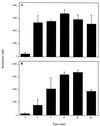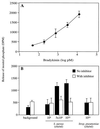Staphylococcus aureus induces release of bradykinin in human plasma
- PMID: 11349054
- PMCID: PMC98413
- DOI: 10.1128/IAI.69.6.3877-3882.2001
Staphylococcus aureus induces release of bradykinin in human plasma
Abstract
Staphylococcus aureus is a prominent human pathogen. Here we report that intact S. aureus bacteria activate the contact system in human plasma in vitro, resulting in a massive release of the potent proinflammatory and vasoactive peptide bradykinin. In contrast, no such effect was recorded with Streptococcus pneumoniae. In the activation of the contact system, blood coagulation factor XII and plasma kallikrein play central roles, and a specific inhibitor of these serine proteinases inhibited the release of bradykinin by S. aureus in human plasma. Furthermore, fragments of the cofactor H-kininogen of the contact system efficiently blocked bradykinin release. The results suggest that activation of the contact system at the surface of S. aureus and the subsequent release of bradykinin could contribute to the hypovolemic hypotension seen in patients with severe S. aureus sepsis. The data also suggest that the contact system could be used as a target in the treatment of S. aureus infections.
Figures






Similar articles
-
The hyaluronan-binding serine protease from human plasma cleaves HMW and LMW kininogen and releases bradykinin.Biol Chem. 2002 Oct;383(10):1633-43. doi: 10.1515/BC.2002.184. Biol Chem. 2002. PMID: 12452440
-
Assembly of human contact phase proteins and release of bradykinin at the surface of curli-expressing Escherichia coli.Mol Microbiol. 1996 Jun;20(5):927-35. doi: 10.1111/j.1365-2958.1996.tb02534.x. Mol Microbiol. 1996. PMID: 8809746
-
Pharmacodynamics of moxifloxacin and levofloxacin against Streptococcus pneumoniae, Staphylococcus aureus, Klebsiella pneumoniae and Escherichia coli: simulation of human plasma concentrations after intravenous dosage in an in vitro kinetic model.J Antimicrob Chemother. 2006 Nov;58(5):960-5. doi: 10.1093/jac/dkl356. Epub 2006 Aug 26. J Antimicrob Chemother. 2006. PMID: 16936293
-
Plasma contact activation: a revised hypothesis.Biol Res. 1998;31(3):251-62. Biol Res. 1998. PMID: 9830513 Review.
-
Mediator responses in surgical infections.Surg Infect (Larchmt). 2006;7 Suppl 2:S3-4. doi: 10.1089/sur.2006.7.s2-3. Surg Infect (Larchmt). 2006. PMID: 16895500 Review.
Cited by
-
The contact system--a novel branch of innate immunity generating antibacterial peptides.EMBO J. 2006 Nov 29;25(23):5569-78. doi: 10.1038/sj.emboj.7601422. Epub 2006 Nov 9. EMBO J. 2006. PMID: 17093496 Free PMC article.
-
Streptococcal inhibitor of complement-mediated lysis (SIC): an anti-inflammatory virulence determinant.Microbiology (Reading). 2010 Dec;156(Pt 12):3660-3668. doi: 10.1099/mic.0.039578-0. Epub 2010 Aug 12. Microbiology (Reading). 2010. PMID: 20705662 Free PMC article.
-
Pathophysiological dynamics in the contact, coagulation, and complement systems during sepsis: Potential targets for nafamostat mesilate.J Intensive Med. 2024 Apr 10;4(4):453-467. doi: 10.1016/j.jointm.2024.02.003. eCollection 2024 Oct. J Intensive Med. 2024. PMID: 39310056 Free PMC article. Review.
-
Streptococcus pyogenes triggers activation of the human contact system by streptokinase.Infect Immun. 2015 Aug;83(8):3035-42. doi: 10.1128/IAI.00180-15. Infect Immun. 2015. PMID: 25987706 Free PMC article.
-
Contact system activation in severe infectious diseases.J Mol Med (Berl). 2010 Feb;88(2):121-6. doi: 10.1007/s00109-009-0564-y. J Mol Med (Berl). 2010. PMID: 20232512 Review.
References
-
- Ben Nasr A, Olsen A, Sjöbring U, Muller-Esterl W, Björck L. Assembly of human contact phase proteins and release of bradykinin at the surface of curli-expressing Escherichia coli. Mol Microbiol. 1996;20:927–935. - PubMed
-
- Bone R C. How Gram-positive organisms cause sepsis. J Crit Care. 1993;8:51–59. - PubMed
Publication types
MeSH terms
Substances
LinkOut - more resources
Full Text Sources
Other Literature Sources
Medical

